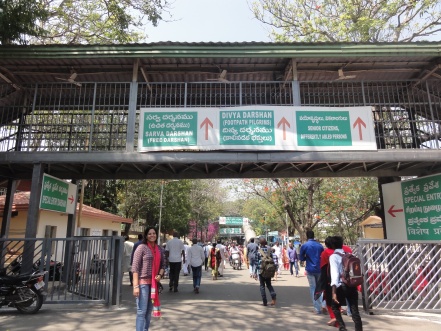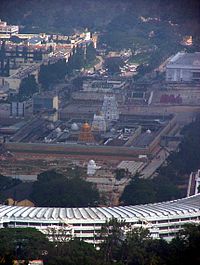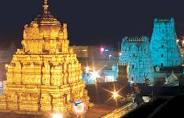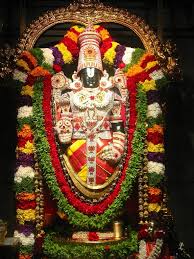Continuing from Part 1, after freshening up, we started to find our way into the temple. At the point of entry of the queue, we found following signboards directing pilgrims towards their designated entry points:

- Special Entry or Seeghra (Quick) Darshan – For those who have paid INR 300 for an entry ticket
- Divya (Divine) Darshan for Footpath pilgrims – For those who walked up the hill
- Sarva or Free Darshan –For those who neither walk up nor are willing to shell out money, but are willing to queue the longest
- Senior Citizens or Differently Abled Persons – The definition is self explanatory
Into the Divya Darshan line we were led into a large room, for depositing our slippers, camera, mobiles etc. to be collected later at the exit point. On to the 1st level security check, we were stopped by the security personal who for some reason got the impression that my friend’s Fitbit is a major security threat and we had to convince them that it was harmless, so better not to carry such devices in future to avoid unnecessary inconvenience. From here, we entered the Vaikuntam complex at 1 pm.
Confined in Vaikuntham (the Mythological abode of Lord Vishnu)

Our first impression of the complex was that it felt like a prison. As rushed forward in a semi-circular corridor, on our right we saw large rooms secured by iron grills right up-to the ceiling and full of people who kind of looked accusingly at us for rushing past them, while we were also mentally counting our lucky stars to be breezing past them. But alas, our glee was not to last. It was not long before we too were herded into a similar room and the doors slammed shut.
Once inside, it took us a minute to take in the fact that it was already crowded with people and we had to find ourselves a place to sit. The room was pie shaped with raised seating and we tried to position ourselves in a place that would not be too far from the door when we are let out. At the back of the room were rest rooms and in front of us, beyond the iron bars we could glimpse some greenery.
Taking in the sights around us, we observed around 400-450 people in the room in various states of activity – sitting and chatting amongst themselves, reading some book, looking at the giant TV screen beaming religious festivities, laying down and sleeping or simply staring keenly at the door expecting it to open any moment. Many, across gender and age groups had freshly tonsured heads. This was the traditional ritual symbolizing sacrifice of attachment to physical beauty and effacing of ego. Most had their foreheads inked with the traditional three pronged Tilak, which was a yellow/red line representing Lakshmi (the consort of Vishnu) in the middle of a white U/Y representing the feet of Vishnu. All (men, women and children) were in traditional attire (Men: dhoti/pyjamas with upper cloth/kurta/angavastram, Women: sari/half-sari/salwar kameez with dupatta) as mandated by the temple authorities. We were sandwiched between 2 similar people filled rooms on either side, which made us reflect on the question – Why is the Tirupati Balaji so famous and attracts such a huge crowd?
Legend/Myth: Once, following a tiff with Vishnu, his consort Lakshmi, left her heavenly abode and came down to earth as Padmavathi. To appease her, Vishnu took the human form of “Srinivasa Balaji” and took residence on the seven hills. There he fell in love with Padmavathi, and approached her father , the Chola king Akasu Raja for her hand in marriage. The king agreed to his marriage proposal provided he paid a hefty dowry. Srinivasa obtained a loan from Kubera, the treasurer of the Gods, on the promise that he would remain on earth till the debt was fully repaid with interest. After the marriage, the husband and wife took up separate residences, with Vishnu living on the Tirumala hill top and the princess bride, locally known as Alamelu Manga, having her own temple at the bottom of the hill in Tirupati. It is also said that Lord Srinivasa turned into a stone idol at the spot where the temple now stands with Lakshmi & Padmavati on his chest to help in the emancipation of mankind from the perpetual troubles of Kali Yuga. So, devotees flock to Balaji’s temple to have a glimpse of the Lord incarnate, make huge offerings of wealth to help him repay his debt and in anticipation of receiving his grace in return.
Locational advantage and patronage of the rich South Indian rulers have also helped in building the temple hype– While the origin of the temple is traced back to 300 AD, it was majorly patronized by the Pallavas (9th century), Cholas (10th Century) and finally the Vijayanagara rulers (14th & 15th century AD), under whom the temple gained most of its current wealth and size. The tradition of donation of gold and jewels was continued by successive rulers of Mysore, Gadwal and the Marathas. As in most other cases, public also followed the example of their rulers and flocked to the temple with huge donations. Besides, Tirumala enjoyed the locational advantage of being in the middle of the dense forest covered Seshachalam hill range and was thus protected from the marauding hordes of the Sultanate rulers, primarily Malik Kafur in the 14th century who had the dubious distinction of rampaging and destroying South Indian temples. This would have further enhanced the myth of the Lord of the hills with an aura of invincibility.
After an hour in the room, we started feeling tired and bored and tried to catch a nap – first in the sitting posture and then laying down curled up in a fetal position trying to avoid hitting someone’s tonsured head with our feet. Another hour went by thus, and there still was no hope of being let out. It was then that we started really value the virtues of freedom and empathize with a prisoner’s feeling in confinement with limited resources of entertainment. But then, maybe this was God’s way of helping us realize and reflect on the Supreme Being – being in a room where there was no distinction or advantage of caste/creed/education/social or economic class and without the frivolous distractions of modern day technology. This was a time to be at ease with one’s own thoughts and God, something we seldom get to do on a daily basis.
Tip: Do carry packed snacks and books in preparation for a long haul.
Every time some guard would pass by the corner, we would rise excitedly hoping to be let out, and finally when we did get a release from the room it was 4.30 pm. We had spent 3.5 hours in the room!
Queueing up again
Once out of the room, we went along the corridor again one level down and this time we tried to stick to the side facing the facing the garden, mentally praying that we not be led into a room again. Now standing in the queue again, we had a good view of the Vaikuntham complex. It was a 3 level semi-circular building with 19 rooms at each level and opened out into a garden. As we waited in the slow moving queue, the heavenly smell of ghee smeared laddoos filled wafted into our noses and all our thoughts were in tasting it.
The corridors of the Vaikuntham complex were connected to the temple through an overhead bridge, descending from which we entered the temple through the main Gopuram. On the way, we saw several age old inscriptions engraved on the walls, some which were irrecoverably damaged by continuous human touch. Before entering the Gopuram, we encountered another level of security check, where I was asked to discard the flower garland in my hair much to my consternation. But, later by the time we were out, I was thankful for having done that.
Into the temple: Be Warned – this part of the date is not for the weak hearted and I mean it literally!

As we entered the 50 feet five storied Gopuram, the single line transformed into a lineless, monstrous crowd with five people standing in leg-space meant for 2. With people breathing, pushing and pulling us from all directions, our major focus was to somehow ensure that we do not get squeezed or stamped on! This stretch is just not safe for the elderly, pregnant women and children and it is strongly advised that they choose alternate options.
Just beyond the main Gopuram and on our left, we got a fleeting glance of the raised Ranganayakula Mandapam. This had housed the idol of Lord Ranganathan from Srirangam for the period 1320 – 1369 AD for safekeeping against muslim invasions. Crossing the Vendivakili (Silver Entrance), we came to the third Bangaruvakili(Golden Entrance) leading to the Garbagriha or the Sanctum sanctorum, where the presiding deity Lord Venkateswara resides. There were two tall copper images of the Dvarapalakas, Jaya & Vijaya on either side of this door and the thick wooden door was covered with gold gilt plates depicting the Dasavathaaram of Vishnu.
Coming face to face with our Date

Finally, into the Garbagriha we were but 20 feet away from our Date, but here too, we had to follow a serpentine 4 layered queue. When we were a few feet away from sighting HIM, we prepared to keep our eyes wide open, since we knew it would be a blink and you miss it situation.
And when we finally face to face at a distance of ~10 feet, we ceased to sense any push or pull around us. All our senses were fixated on our date – the four handed standing deity (one arm placed on the thigh, one in the yogic varada posture and the other two holding a Sankha and Sudarshan Chakra), the Goddesses Lakshmi & Padmavathi on his chest and beautifully adorned with precious ornaments. And for those precious few seconds, we felt a rush of achievement and enlightenment. Reflecting later on whether it is the glorious idol that signifies God on earth, I felt that you may have as well replaced it with a plain stone or even nothing for that matter, and we would have felt just the same. It is the collective positivity of all devotees which creates the ambience of heaven and this can be achieved in any place on the earth!
The Darshan did not signal the end of the day and exiting the temple was another fight, as the same gate was used for both entry and exit. It had all the ingredients for a potential stampede and we avoided joining the line to the big Hundi as we just did not feel up to the fight to make a donation. By the time we were out after collecting our Laddoo prasads, the sun had carved a right angular path in the sky and was well below the horizon!
We ended our day with some shopping and just strolled about the place to soak in the vibrant ambience, key attractions being the DeepaAlankara Seva held to the Utsava Moorthi in the open grounds, the cultural programs and various vendorspeddling colorful stuff. Later in the night, as we enjoyed our Prasad – the famous Tirupati Laddoos, we realized that we still owed a debt to the Lord (having skipped making any monetary contribution) and had all the reason to make another trip. Most likely we would do it on a day in the middle of the week, thus avoiding the massive weekend and other auspicious day crowds, as the Lord is likely to remain just as special & powerful on all days!



 It was 4 am in the morning when we got down the bus in the Tirupati bus stand and caught an auto to Alipiri. Located at the foothills of the Seshachalam hills, Alipiri means ‘Resting Place’ and so served pilgrims in earlier days when they had no option, but to trek up the hills to see the Lord. Alipiri was abuzz with activity as we headed straight to the luggage counter for depositing our bag. This would be transported up the hills by road to be eventually collected by us once we reach the top. Going through a subway and on to the steps, we saw many people begin their journey by the traditional ritual of breaking a coconut and lighting some camphor.
It was 4 am in the morning when we got down the bus in the Tirupati bus stand and caught an auto to Alipiri. Located at the foothills of the Seshachalam hills, Alipiri means ‘Resting Place’ and so served pilgrims in earlier days when they had no option, but to trek up the hills to see the Lord. Alipiri was abuzz with activity as we headed straight to the luggage counter for depositing our bag. This would be transported up the hills by road to be eventually collected by us once we reach the top. Going through a subway and on to the steps, we saw many people begin their journey by the traditional ritual of breaking a coconut and lighting some camphor.












 Step#2850 marked the Sri Lakshmi Narasimhaswamy temple and point for getting our Divya Darshan tickets stamped (guess this is to ensure that pilgrims do not cheat by hiking a ride up after getting the darshan tickets). Finally, at step#2910, we came to the Mokallimitta (‘knee-breaker’) GaliGopuram which marked the final and steepest stretch of the journey. Here, we were amazed to see many people arduously climbing up the stairs on their knees. Apparently, this is an attempt to replicate the feat of the Vaishnav saint, Sri Ramanujacharya, who in his visit to the temple in c.1050 AD had been most challenged by this section of the journey and had to crawl up the hill on his knees.
Step#2850 marked the Sri Lakshmi Narasimhaswamy temple and point for getting our Divya Darshan tickets stamped (guess this is to ensure that pilgrims do not cheat by hiking a ride up after getting the darshan tickets). Finally, at step#2910, we came to the Mokallimitta (‘knee-breaker’) GaliGopuram which marked the final and steepest stretch of the journey. Here, we were amazed to see many people arduously climbing up the stairs on their knees. Apparently, this is an attempt to replicate the feat of the Vaishnav saint, Sri Ramanujacharya, who in his visit to the temple in c.1050 AD had been most challenged by this section of the journey and had to crawl up the hill on his knees.


